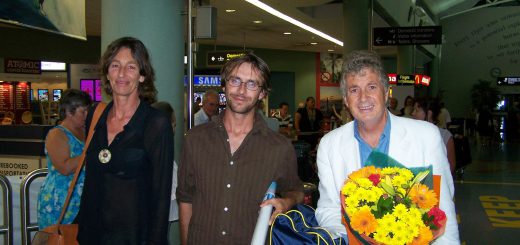Gecko release on tiny Crusoe Island – brings to a close ARC legacy programme

Multiple translocation of common geckoes from Noises Islands to Crusoe and Motuora Islands. October 2010
Last Thursday I finally got to achieve an ambition I have had since 1996. In its last ‘legacy project’ the ARC released 30 common geckoes Hoplodactylus maculatus onto Crusoe or Papakohatu Island in the inner Hauraki Gulf.
Crusoe (0.7ha) lies approximately half way between Motuihe and Waiheke Islands. Despite its presence in one of Auckland’s most popular fishing grounds (the Motuihe channel) the island remains in many respects ‘invisible’.
While most conservation attention focuses on the more larger islands like Little Barrier, (Hauturu), Rangitoto, Motutapu, Tiritiri Matangi and Motuihe, it is not generally appreciated that the much more numerous islets (less than 1 hectare in size) of which there are 350 in the Hauraki Gulf alone have significant existing and potential conservation values – especially for seabirds and reptiles.
The release of common geckoes (as well as shore skinks) on Crusoe Island has been a personal project of mine since I first carried out a biological survey of the island as part of my MSc degree in 1996. When I first visited the island in late January 1996, paddling by kayak from Waiheke, I discovered the island had been overrun with mice and its native vegetation infested with Rhamnus alaternus – an especially aggressive pest weed plant. After a false start in 1996 in 2001 I finally managed to eradicate the last mouse from Crusoe.
I always puzzled given the distance of Crusoe from the nearest neighbouring islands how mice ever got there in the first place and by chance recently I came across an account of how a Sanford fishing boat the Olive ran aground on Crusoe Island in October 1949 and as part of the salvage operation everything on the boat had to be unloaded onto the island. This would certainly explain how mice got there. Over recent years Rhamnus and other weeds have been progressively removed from Crusoe Island by ARC Biosecurity staff and myself – with Whakanewha parks ranger Andy Spence and Dan Beauchamp actively involved. The island is now well covered in native coastal forest is in extremely good condition.
The geckoes were collected from Otata Island in the nearby Noises Group by Melinda Rixon for the ARC. Melinda is an expert on native lizards (herpetologist) and runs an environmental management company Te Ngahere. This release was combined with the transfer of 40 other common geckoes from Otata to Motuora Island. Native geckoes are quite unique as they give birth to live young. Common geckoes normally give birth to twins around about March.
Earlier this year, in January and in March we also released a total of 74 native shore skinks Oligosoma smithii on Crusoe. The first release in early January comprised of 33 shore skinks which were were captive-bred at Massey University, Albany Campus in a programme run by Dr Weihong Ji.
The second release in March comprised of 41animals, which were all were collected from Tawharanui Regional Park.
The whole project was managed by ARC Natural heritage scientist Matt Baber (also a lizard specialist).
The lizard releases of 2010 are considered to have an excellent chance of success.
We are very appreciative of the support given by the Neureuter family who own the Noises Islands and of course Melinda who expertly collected the 70 geckoes involved in the double translocation.
The completion of this project which was approved by the ARC in 2008 brought to a close a long list of ARC legacy projects this year – ranging from opening Newmarket Station, opening the Hillary Trail, opening Queens Wharf, reopening the Onehunga Branch Line and Onehunga Station (proving to be extremely popular), building a heritage tramway on the Wynyard waterfront, buying one more large coastal regional park, Te Muri, publishing a history of regional parks (‘Dreamers of the Day’) and releasing 100 bellbirds on Waiheke Island and 50 on Motuihe Islands – that we achieved in this very eventful year.
To know that Crusoe – small as it is – has been restored to an almost pristine condition and stocked with native lizards is extremely satisfying.
Our application to release Pacific Geckoes from Little Barrier Island on Crusoe was put on hold by Department of Conservation but could happen in the future. Special thanks to Mick Courtnell from the Auckland Harbourmaster office for transporting us and the lizards to Crusoe -and for bringing us back.
For more details on Crusoe Island see: Lee (1999) Biota of Seven Islets off Waiheke Island, inner Hauraki Gulf. Tane 37: 99-136.




